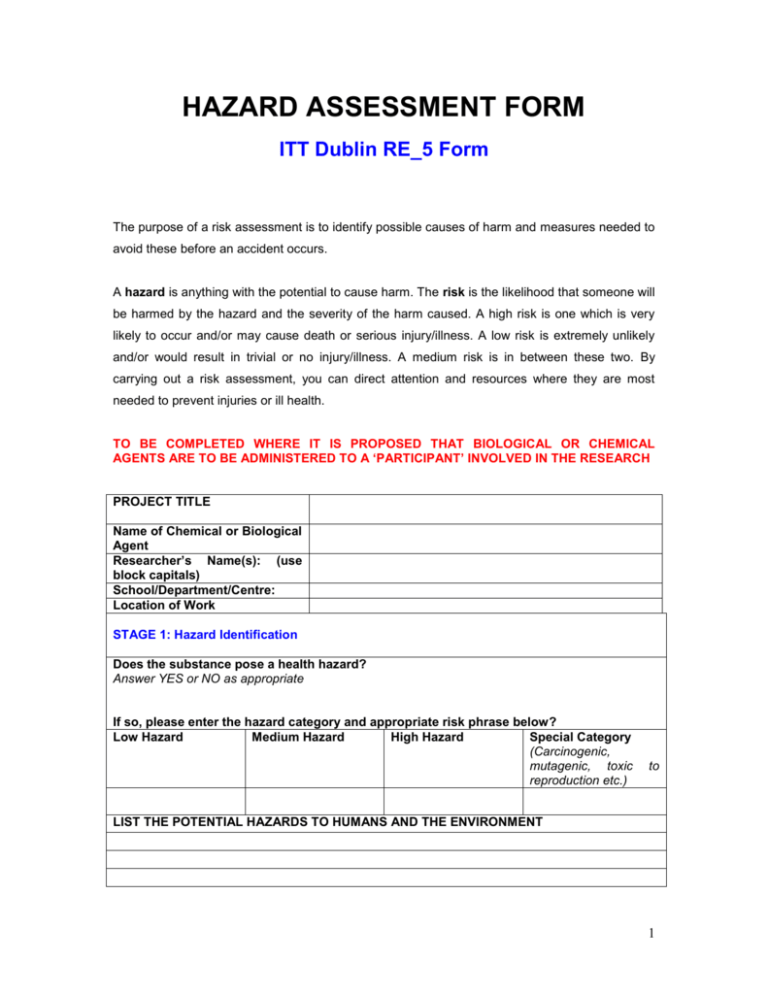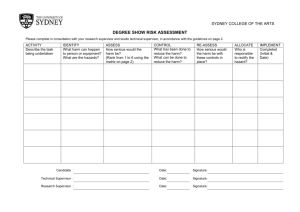ITT Dublin RE_5 Form
advertisement

HAZARD ASSESSMENT FORM ITT Dublin RE_5 Form The purpose of a risk assessment is to identify possible causes of harm and measures needed to avoid these before an accident occurs. A hazard is anything with the potential to cause harm. The risk is the likelihood that someone will be harmed by the hazard and the severity of the harm caused. A high risk is one which is very likely to occur and/or may cause death or serious injury/illness. A low risk is extremely unlikely and/or would result in trivial or no injury/illness. A medium risk is in between these two. By carrying out a risk assessment, you can direct attention and resources where they are most needed to prevent injuries or ill health. TO BE COMPLETED WHERE IT IS PROPOSED THAT BIOLOGICAL OR CHEMICAL AGENTS ARE TO BE ADMINISTERED TO A ‘PARTICIPANT’ INVOLVED IN THE RESEARCH PROJECT TITLE Name of Chemical or Biological Agent Researcher’s Name(s): (use block capitals) School/Department/Centre: Location of Work STAGE 1: Hazard Identification Does the substance pose a health hazard? Answer YES or NO as appropriate If so, please enter the hazard category and appropriate risk phrase below? Low Hazard Medium Hazard High Hazard Special Category (Carcinogenic, mutagenic, toxic reproduction etc.) to LIST THE POTENTIAL HAZARDS TO HUMANS AND THE ENVIRONMENT 1 STAGE 2: Hazard Evaluation (See guidelines at the end of this form, page 3) Risk Assessment Frequency Risk Number Control Strategy (Avoid, reduce etc.) Control Consequence Assessment completed by: Print Name: Signature: Date: Approved by Head of Dept./School Print Name: Signature: Date: STAGE 3: Safety Information a. Properties Enter any known chemical and physical property data. Where an entry is not applicable, then enter N/A pH = Auto ignition temp. = b.p./b.p. range = Oxidizing properties: m.p./m.p. range Reducing properties: Flash point Explosive properties/limits: Decomposition temp.: Solubility: b. Stability & Reactivity Enter any known stability and reactivity data. Where an entry is not applicable, then enter N/A Is the compound stable or not? Materials to avoid: Incompatibilities: Hazardous decomposition products: Does hazardous polymerization occur? In accordance with the ITT Dublin Code of Good Research Practice, I declare that the information provided in this form is true to the best of my knowledge and judgement. Signature of applicant 1: Date: Signature of applicant 2: Date: Signature of applicant 3: Date: 2 Guidelines for completing STAGE 2: 5 x 5 Risk Assessment Method Frequency Number 1 2 3 4 5 Consequence Number 1 2 3 4 5 Descriptor Unlikely, little chance Not expected but could occur Likely – even chance Probable Certain Descriptor Cut, scratch, bruise Temporary short minor illness, fracture of minor bone Permanent minor illness, fracture of major bone Loss of limb or eye, temporary serious illness Loss of two limbs or eyes, permanent serious illness or fatality RISK NUMBER = FREQUENCY x CONSEQUENCE RISK NUMBER = 1 => Negligible Risk RISK NUMBER = 25 => Disaster RISK NUMBER > 16 => Control must be put in place 3





